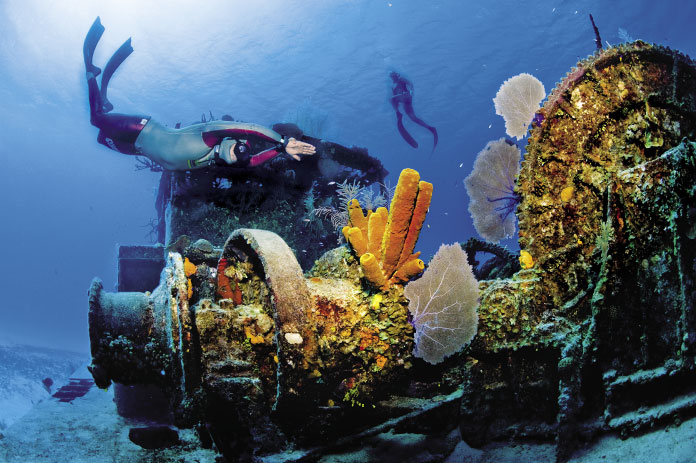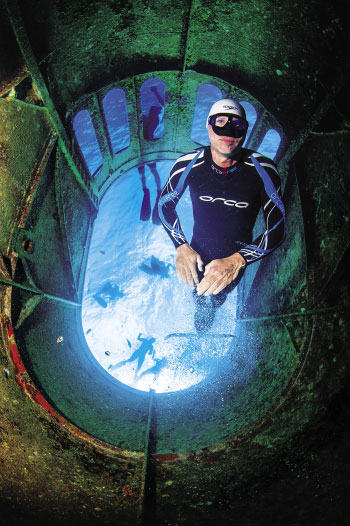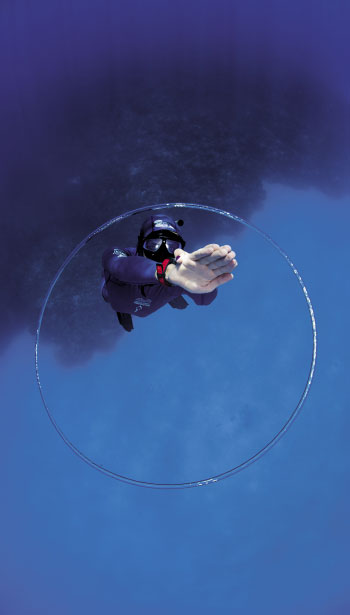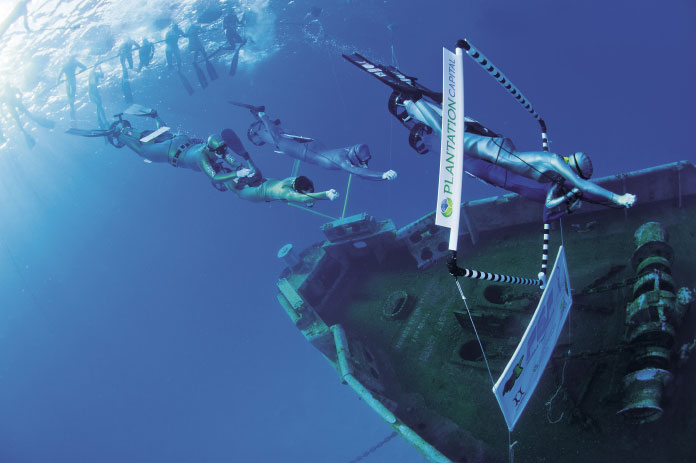Tom Gilmore has had his face in the water for five minutes and counting, when the contractions begin, crashing through his body like waves.
He’s holding on to the side of the pool, bucking like a blue marlin on the end of a fishing line, but when the official asks, he raises a finger and signals clearly that he is okay.

When he finally lifts his head and takes a cleansing lungful of air, 6 minutes and 33 seconds have elapsed. It’s not a personal best, but it is a good time and more importantly he has managed not to pass out. It is a clean score and Tom moves towards the top of the leaderboard.
Less than 24 hours later, out on the open ocean, it is Kurt Randolph’s turn to excel.
With the weight of water pushing him onwards, he doesn’t need to swim.
He just sinks effortlessly towards his target, an anchor plate attached to a line, 230 feet below the surface.
Even in the clear blue of the Caribbean Sea, he’s reached a depth where sunlight struggles to penetrate.
It’s a long way back.
But he stays calm and kicks upwards, towards the light.
As he breaches the surface, the official scans his face, looking for a tell-tale tremble in the lips that would signal a loss of motor control. But he sees only a smile and an okay signal. It’s a clean dive and a solid score that puts him in the frame for the championship.

It is the annual Deja Blue freediving competition in the Cayman Islands and Randolph and Gilmore are among a group of elite athletes, performing a series of feats that seem to defy the laws of physics and human biology.
During the week-long competition, they compete in various disciplines, hitting depths in excess of 200 feet, holding their breath for five minutes or more, swimming multiple lengths of the Camana Bay pool under water.
In their spare time they explore, on a single breath, the chambers of the USS Kittiwake shipwreck and the caverns of Eden Rock on the reefs off George Town.
It shouldn’t be possible. Surely Gilmore should be brain dead from lack of oxygen, and Randolph’s chest should cave in, under the intense pressure of the deep ocean.
The science of freediving, not properly understood until the 1960s, is explained in a seminal scientific publication by physiologist Per Scholander, poetically titled, the Master Switch of Life.
The Swedish scientist identified and explained a concept, which he observed in Weddell seals, called the mammalian dive reflex, a series of physiological changes that occur on contact with water, including a dramatic drop in heart rate.
During that mammoth breathhold, Gilmore’s body underwent a series of life preserving changes.
As soon as his face hit the water, his heart rate began to decrease.
After around a minute he would have felt the first mild discomfort – a signal from the brain’s stretch receptors that the breathing muscles were not flexing in their normal pattern.
Two minutes in, for the average person, carbon dioxide build up would start to trigger the urge to breathe. An experienced freediver like Tom feels little impact at this point.
After three minutes a more profound change begins to occur. The arteries carrying blood to the arms and legs constrict, concentrating blood flow in the body’s core and dedicating the now limited oxygen supply to the critical organs – the heart, the brain and the liver.
Around the four minute mark, the spleen contracts, causing the release of a reserve force of oxygenated red blood cells.
 At five minutes his heart rate has reduced to as low as half its normal rate – around 25 beats per minute.
At five minutes his heart rate has reduced to as low as half its normal rate – around 25 beats per minute.
After six minutes the build up of carbon dioxide – a waste product in the breathing cycle – has become almost unbearable and starts to trigger those intense full body contractions, the last urgent reminder to breathe.
Everyone has a different break point, and Tom’s comes just before the seven-minute mark. Had he held on any longer, he would eventually have passed out from oxygen deprivation.
For Randolph on his 230 feet dive, the same phenomena were taking place in tandem with a whole new set of reactions to depth.
Aside from holding his breath, he has the added problem of exponentially increasing pressure that will crumple and fold his lungs like a raisin.
About halfway to his target at 115 feet, where the pressure reaches 65 pounds per square inch, was previously thought to be the point at which the chest cavity would implode.
Before this happens, the body diverts blood plasma, incompressible fluid, into the empty space to equalize the pressure.
At 230 feet, his lungs would have shriveled to a seventh of their size at the surface – around the size of a grapefruit, but this thoracic filling, keeps his skeleton intact.
It is this chain of reactions that makes the sport of freediving possible.

Randolph, a 28-year-old Ohio native who lives in Grand Cayman, and Gilmore, a 55-year-old ex-army vet from Florida, have trained their bodies to access this mammalian dive reflex almost automatically.
They have put themselves through grueling training regimens to learn to tolerate high levels of CO2 and to suppress the mental demons telling them to breathe.
But they are not super human or even unique.
According to world champion Ashley Chapman, in Cayman for the competition and to teach the sport to a group of students, including me, anyone can learn to hold their breath for four minutes and go as deep as 100 feet with just a few days training.
It starts with a simple mantra.
“You have to believe you’re not going to die.”
A rudimentary understanding of the scientific theory is one thing. But as I find out, putting it into practice is very different.
The first time I try to hold my breath, I manage barely a minute, before succumbing to a rising sense of panic.
As the course progresses and we learn some simple breathing exercises, I find I can relax and trust the science.
It takes some effort, in the initial stages of a long breath hold, to override the instinct and muscle memory that has synced to a more normal breathing cycle.
But there is a point at which the body begins to accept the new conditions, the heart rate starts to drop, and you begin to feel a sense of comfort, even bliss.

I’m in this zone, face in the water, hands gently holding to the edge of the pool, when I feel a tap on my shoulder to indicate I’ve hit the three-minute mark.
Around this time, I start to feel the first physical contractions, reminding me it might be a good idea to replenish my plunging oxygen levels.
There is a more persistent voice inside my head, commanding me to breathe.
I hold on, in defiance, for another 30 seconds, but the logic is compelling. Three-and-a-half minutes under water seems insane. It just doesn’t feel like it should be possible.
According to Chapman, the barriers to going further are mental, not physical.
“It is all about having that tolerance for discomfort and the unknown,” she says.
Freediving is, in a sense, competitive relaxation. The key to success is unlocking that contradictory combination of attributes, maintaining an intense focus while remaining perfectly calm in extreme circumstances.
“The only way that it works is to be 100 percent relaxed. You have to surrender to the ocean,” says Chapman.
“You remind yourself that you’re not going to die, everything is fine, then you go as deep as you want to go.”
As reassuring as that sounds, there is undeniably an element of risk. People DO die freediving.
At various points during the tournament, competitors push themselves to the point where they black out from oxygen deprivation.
In normal circumstances, says Chapman, this is comparatively rare. But in a competitive environment, with athletes targeting records, and with the comfort of knowing a trained safety crew is on hand, risks are taken.

Loss of consciousness in freediving, known as shallow water blackout, almost always occurs close to or at the surface because of the drop in oxygen pressure in the body on ascent.
Protective reflexes prevent the stricken diver from inhaling water, but without direct intervention from a buddy, drowning and death are imminent dangers.
Chapman acknowledges the risks but says they are easily mitigated through following safety procedures and always diving with a buddy.
“Every time you get in your car, you don’t know for sure that you are not going to die.
“But you wear your seatbelt, you drive sensibly, you take the right precautions. The more you do it, the more it becomes obvious.”
As fascinating as the “what” and the “how” of freediving, is the “why?”
Casual observers have a hard time understanding why anyone would risk drowning for a few brief minutes beneath the ocean’s surface.
Spearfishing or exploring magnificent coral reefs and shipwrecks provide only part of the answer.
All are possible on SCUBA and they don’t explain the desire to go deeper, for longer, or the addiction that freedivers have to the process of breath holding itself.
Many of the competitors speak almost philosophically about what drives them to dive. They describe a sense of pure focus, or flow, that takes them out of themselves and their everyday concerns.
When you are 200 feet under water and at least a minute away from your next breath, all other concerns tend to fade into the background.
“I used to be the kind of guy that got angry in traffic a lot,” says Gilmore, a deceptively intense-looking ex-military guy who describes learning to dive as a journey of self discovery.
“It has helped me relax and concentrate on myself. It helps me be more centered, more balanced, and it extends to all other aspects of life.”
For me, even at an introductory level, learning to hold my breath for more than three minutes and diving to 65 feet, feels like accessing a hidden super power.
Chapman gets that vibe from a lot of students.
“It is unusual to learn something new about your body and about who you are,” she marvels.
“People have no clue what they are capable of.”


















